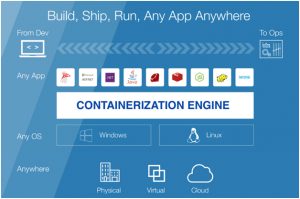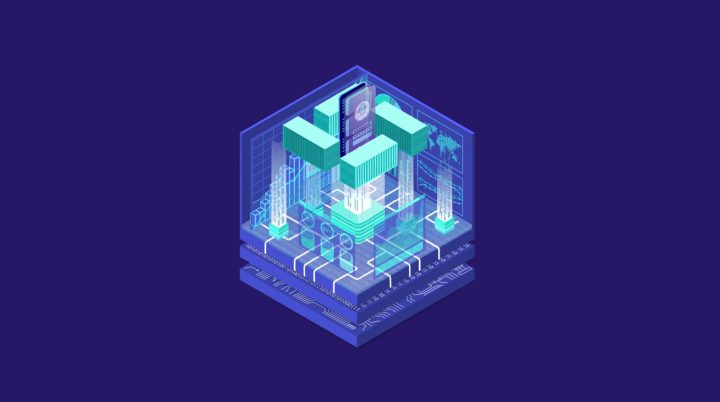What is Containerization?
Containerization is a technology and software deployment approach that allows for software products and applications (code, as well as components such as libraries, frames and other dependencies) be grouped into self contained components that can be easily deployed, scaled and updated. As a result, software and services are packed in containers. As in the real world, physical containers (i.e., metal boxes used to send goods from one place to another) are (relatively) lightweight and portable. Before the broad adoption of containerization, the most popular way to deploy applications was through virtualization or virtual machines. Virtualization has been a key catalyst for cloud adoption, but containerization offers ways to speed up the journey and reap greater benefits.
Containers enable developers to move apps more quickly and easily from one environment to another. For example, you may want to create an application in one public cloud, move it to another for testing, and then place it on premises in a private cloud for production.
By using technologies such as clustering, scheduling and orchestration methodologies, businesses can assess the scale and resiliency capacity of applications that are containerized. At the same time, it is just as important to integrate containers into existing infrastructure to generate more.

Key use cases of Containerization
- Cloud Adoption- Containerization can help you transfer workloads to the cloud and between different kinds of cloud and providers and a properly implemented and operated containerization platform can provide a standardized means of developing, deploying, securing and exploiting workloads. Containerization also allows organizations to develop services in a centralized manner and then push them to peripheral locations for maximum benefits.
- It Transformation- Containers are essential for application modernization, financial operations, sustainable IT and global IT modernization efforts. In this regard, containerization helps to accelerate delivery, reduce support costs and better utilize existing resources (e.g., physical servers and purchased cloud infrastructure).
- Industry-To succeed in the fourth industrial revolution, IoT, artificial intelligence, machine learning, data analysis and more will need to be deployed and used effectively. It will also mean being able to simulate various scenarios using digital twins, connecting micro services quickly and efficiently using APIs, and accelerating development. Containerizing is a key element of all these technologies and ambitions.
- Business Innovation- Technologies and approaches such as micro services, digital twins, data, science, machine learning and the development of cloud-based applications play key roles in the pursuit of business innovation. Containerization enables micro-services to be developed and operated on a large scale. It also allows access to computing power and scaling upon request to support data science, machine learning and digital twins. Additionally, containers are a fast and efficient way to host, deploy, scale, and operate cloud-based products and applications.
Benefits Of Containerization
- Efficiency- Containerization is one of the most effective virtualization methods that developers can use. Containers improve efficiency by utilizing all available resources and minimizing overhead. When correctly configured, containers allow a host to leverage virtually every resource available. Isolated containers can operate without interfering with other containers, enabling a single host to perform multiple functions. Containers also eliminate the need for virtualized operating systems, hypervisors and other bottlenecks typically introduced by virtualization techniques.
- Agility- Containerization is an essential tool in rationalizing DevOps workflows. You can create containers quickly; expand them into any environment, where they can be used to solve several Dev-Ops challenges.
- Faster Delivery- Containerization resolves this problem by segregating your application. You can divide even the biggest beast of an application into discrete pieces with the help of micro services.
- Improved Security- The isolation introduced by containerization also provides a further level of safety because containers are insulated from each other, you can be sure that your apps work in their own standalone environment.
- Faster App Startup- Relative to other virtualization methods such as VMs, containers are extremely light. One of the numerous advantages of being light is quick start time.
- Flexibility- Containerization makes it possible for developers to exploit their code in a virtualized or bare-metal environment. Regardless of the deployment requirements, containerization can be elevated to meet these requirements. Containerized applications using microservices are becoming so flexible that you can host certain items on bare metal and deploy others in virtual cloud environments.

Drawbacks Of Containerization
- It is essential that you learn the limitations associated with container safety before using them to build your applications.containers in the cloud don’t have the same security limits as virtual machines.
- Most importantly is the notion that hackers now have two domains they can exploit. They can find a shortcoming in the operating system for accessing the container, or they can find vulnerability in the container for accessing the underlying server.
- The container creation process is another issue because the container will be as safe as the safety status of the organization generating it. This is especially important when taking advantage of the containers in public depots. You must make sure that you are downloading a safe and legitimate container.
- Not every application is appropriate for containers, and their use makes these applications more complex than they should be. It is preferable to let some monolithic applications.
- The containers are of different breed than virtual machines, since a virtual machine is integrated into the operating system, drivers and application components, it’s pretty easy to shift a virtual machine to any other cloud platform.
- Therefore many Linux containers developed for Docker, cannot work on the current version of Windows Server. The situation is improving rapidly, but there are still some inconsistencies.
Which Apps and Services are Routinely Containerized?
A container can support almost any kind of application that in earlier times would have been traditionally virtualized or run natively on a machine. At the same time, there are a number of computer paradigms that are particularly well suited to containerization, including:
- Microservices- A Microservices architecture can be configured effectively as a set of tandem and extruded containers and taken out of service as required.
- Databases- The database fragments may be containerized and each application has its own dedicated database instead of having to connect them all to a monolithic database.
- Web Servers- Running a web server in a container requires only a few command-line inputs to start, in addition to avoiding having to run the server directly on the host.
- Containers Within the VMs- Containers can be run in virtual machines, typically to optimize hardware usage, talk to specific services in the virtual machine, or increase security.
- ADCs- An application, diffusion controller control the performance and safety of an application. When containerized, L4-L7 services are more easily accessible within DevOps environments.
Conclusion – Containerization is a multi-purpose technology that offers a wide variety of computing applications. Properly applied, containerization increases DevOps efficiency; accelerates deployment, simplifies workflow, and reduces infrastructure conflicts. It also makes it easier for developers to use the available resources.
